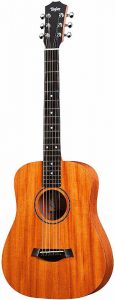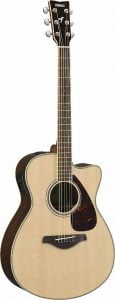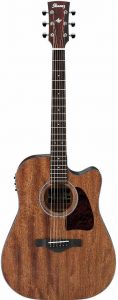Best Acoustic-Electric Guitars Under $500 Reviewed
Acoustic electric guitars are my instrument of choice, so I’ve chosen four of my favorites available for under $500.
At the bottom ranking, you’ll find the Baby Taylor BT2-e from Taylor Guitars. It’s a decent electro-acoustic, but its price-to-value ratio makes this guitar the least desirable.
In the #1 Spot is the Epiphone Hummingbird PRO. I loved everything about it: its loud, full-bodied tone as well as an awesome look!
Top Rated Acoustic-Electric Guitars Under 500 Dollars
Epiphone Hummingbird PRO

- Top – Solid Spruce
- Body – Wood
- Neck – Select Mahogany
- Back – Select Mahogany
- Fingerboard – Rosewood
- Electronics – Shadow ePerformer HD Preamp+Shadow NanoFlex HD pickups
The Epiphone Hummingbird PRO acoustic electric guitar is a remake of Gibson’s 1960s Hummingbird model, but differs with its laminate back and modern electronics. It sounds similar to the FSX830C since their woods are much the same, but is louder with its square-shoulder dreadnought body. I’ve always been a fan of Epiphone’s SlimTaper “D” neck profile, and it makes the Hummingbird PRO a versatile guitar for different genres.
I think the Shadow electronics convey maybe a bit too much of the solid spruce top’s high end, but this can be overlooked with the right EQ settings on a good amp.
I’m not really keen about the big flashy pickguard, and on an acoustic electric I highly prefer a cutaway so I can shred the high end. But, if you’re looking for a quality, affordable acoustic electric and are okay with the vintage look, the Hummingbird PRO is a great guitar for beginner to semi-pro players.
Final Verdict
The Hummingbird PRO clocks in about $150 less than the Taylor Baby Mahogany-e, yet delivers decibels more of volume. Unless you’re looking for a smaller guitar, it’s overall a better buy than the BT2-e or the FSX830C. I’m not greatly impressed by the Shadow pickup, but wouldn’t hesitate to play a smaller show with this guitar.
Pros
- Loud, well-rounded acoustic tone
- Affordable remake of famous vintage guitar
- SlimTaper “D” neck profile for faster playing
Cons
- No cutaway limits upper fret access
- Unremarkable electronics
Fender CD-60SCE
Specs
- Top: Mahogany
- Body: Mahogany
- Back: Mahogany
- Neck: Mahogany
- Fretboard: Walnut
Pros
- Fender “Easy-to-Play” neck shape for fast, easy fretting
- Cutaway for smooth shredding of the upper frets
- Solid spruce top with great projection
Cons
- Inferior plastic pickguard
- Fret buzz in some instances
Review
Fender consistently earns top rankings in our reviews, and the Fender CD-60SCE is a shining example. This sleek electro-acoustic dreadnought offers exceptional playability with its wide cutaway and smoothly tapered neck, delivering the quality expected from any Fender instrument. Its classic tonewood combination produces a bright and clear tone that is faithfully captured by the Fishman pickup. While it may not be the loudest guitar, its value far surpasses its price tag.
When you receive the Fender CD-60SCE, the action is set low for comfortable chord fretting. However, you may need to make minor truss rod adjustments to eliminate any fret buzz and raise the strings.
In my experience, Fender’s affordable range guitars are ideal for beginners, but intermediate players seeking to expand their collection will also find great enjoyment and value in this model.
We also included Fender CD-60SCE to the following categories:
Yamaha APX600
Specs
- Top: Spruce
- Body: Mahogany
- Back: Mahogany
- Neck: Mahogany
- Fretboard: Rosewood
Pros
- Sturdy construction will hold up against inevitable bumps and bangs
- A great high-end student guitar
- Beautiful, complex tone
Cons
- No clear info on body and neck tonewoods
Review
Despite being relatively unknown, the Yamaha APX600 has become one of my personal favorite Yamaha guitars.
While the lack of information about the specific woods used may be a turn-off, a brief test run of the APX600 will reveal that Yamaha’s secrets do not hinder them from crafting an excellent acoustic-electric guitar.
This model boasts a remarkably clean and versatile sound, shining in every range and excelling in genres ranging from hard-stomping outlaw country to delicate fingerpicked folk.
Despite being a laminate-top guitar, the unique oval soundhole and specially-designed non-scalloped X-bracing result in a full, natural sound rarely found in other beginner models.
When connected to an amplifier, Yamaha’s SYSTEM65 preamp breathes life into this guitar, delivering each range with sonic purity and avoiding any unpleasant tinny tones, even in the highest frets.
With its narrow string spacing and cutaway body, the APX600 allows you to effortlessly explore your musical ideas without straining your hand, making it perfect for practicing any technique you desire.
We also included Yamaha APX600 to these categories:
Epiphone PR-4E
Specs
- Top: Spruce
- Body: Mahogany
- Back: Mahogany
- Neck: Mahogany
- Fretboard: Rosewood
Pros
- Amazing value players pack featuring an amp, a cable, and more
- Decent tonewood combo
- Made by a highly dependable company
Cons
- Mass-produced laminate guitar
Review
Epiphone consistently impresses us, much like Fender and Yamaha, across their range of electric, hollow body, and acoustic guitars, making it no surprise as a subsidiary of Gibson.
While the Epiphone PR-4E may not reach the pinnacle of overall quality, it deserves a special mention for its extraordinary bundle. Here’s why:
Although I typically have reservations about laminate top guitars, favoring solid top instruments, the PR-4E breaks the mold with its exceptional value. For under $300, you not only receive the PR-4E guitar but also a complete package to unlock its amplified potential.
This comprehensive player pack includes the guitar itself, a 1/4″ instrument cable, a strap, a set of picks, a tuner, AND AN AMPLIFIER. Considering that the price of an amplifier alone often surpasses the cost of most other guitars on our list, the PR-4E player pack is an absolute steal.
The guitar itself is a solid acoustic-electric with a respectable tone. While it may not stand out as extraordinary, it confidently holds its own. If I had discovered this incredible bargain when purchasing my first acoustic guitar, I would have eagerly seized the opportunity. Therefore, if you’re a beginner eager to embark on your guitar journey, I highly recommend taking advantage of this offer.
We also included Epiphone PR-4E as a great pick for these categories:
Baby Taylor BT2

- Top – Solid mahogany
- Body – Sapele
- Neck – Sapele
- Fingerboard- Ebony
- Electronics – ES-B pickup/preamp with onboard tuner
The Taylor Baby Mahogany-e acoustic-electric is one of the best Taylor models under $1000. It has has a ¾ size dreadnought body and is great for kids, players with small hands, or those looking for a travel-friendly acoustic. Its mahogany top and Sapele neck, back, and sides form a tonewood blend that creates a tone with punchy, warm fundamentals up and down the 22 ¾ inch scale length. I love how fast it feels to play with the naturally oily ebony fretboard and neck slimmer than most electrics.
You get all the earthy warmth you’d expect from a solid mahogany top, but the small body size keeps this acoustic on the quiet side. It’s great as a practice guitar or for songwriting, but can’t really compete in a multi-instrumental jam.
However, with a good amp, you can bring the Baby Mahogany-e to life. The ES-B pickup/preamp combo features Taylor’s Expression System 2 design, and I agree with Taylor that this behind-the-saddle design truly translates the acoustic’s natural tone.
Final Verdict
If Taylor had gone with scalloped bracing for extra volume I’d be happier with the Baby Mahogany-e, but I’m gonna need more bang for my buck. The neck and body are quite small, so if you have huge hands you’ll have a problem fretting the tighter chord shapes. The BT2-e is on this list because it’s the best small sized acoustic electric, so keep reading if you’re looking for a full-sized instrument with more kick for the cash.
Pros
- ¾ body size great for travel
- Preamp runs ~300 hours on new batteries
- Left-handed version at no additional cost
Cons
- 19 frets and no cutaway limit playing range
- Big price, little guitar
Yamaha FSX830C

- Top- Solid Sitka spruce
- Body- Rosewood
- Neck- Nato
- Fingerboard- Rosewood
- Electronics- System-66 preamp with SRT piezo pickup
With a solid Sitka spruce top and mahogany back and sides, the FSX830C is a guitar that will age well, deepening both in color and in tonal complexity. New, I think its tone lacks character, although as a fan of mahogany I enjoy the warmth in the midrange.
I like the concert style combined with the single cutaway body design. Once you start playing acoustic electric you’ll want to explore the higher ranges, and the FSX830C gives easy access to the highest frets.
When I plug in I like to have as much control over my tone as possible, so I really appreciate the versatile System-66 preamp controls. Paired with the meticulously designed Yamaha SRT piezo pickup, I think the professional plugged-in capabilities of this guitar make up for its uninspiring unplugged voice.
Final Verdict
The Yamaha FSX830C acoustic electric is a great mid-range guitar. Its concert body sits really comfortably, and its thin rosewood neck feels fast and fun to play on. I wish there were more overtones out of the box, but I wouldn’t mind loving this guitar through its boring years to one day appreciate the beauty it will develop in its maturity. The FSX830C would be a contender for top-spot, but its price tag is a bit too high to compete with the next guitars on the list.
Pros
- Professional-grade electronics
- Comfortable concert body shape
- Articulate and loud
Cons
- Could be more affordable
- Best tone comes with age
Ibanez AW54CE

- Top – Solid mahogany
- Body – Mahogany
- Neck – Mahogany
- Fingerboard – Ovangkol
- Electronics – Fishman Sonicore pickup, Ibanez AEQ-SP2 preamp
I’ll top off this review with the lowest cost guitar with the highest value, the Ibanez AW54CE. The tone of the all-mahogany cutaway dreadnought body is on its own worth much more than the price tag. Coupled with the dependability of the Sonicore pickup and Ibanez preamp, I’d be as comfortable with this guitar on stage as practicing alone. It’s loud, it’s warm and woody, and it plays like a dream. Don’t be turned off by the unusual use of ovangkol for the fretboard; its smooth-playing feel and responsive tone is so similar to rosewood you won’t notice any difference.
Final Verdict
Ibanez saved on time and cost by producing the AW54CE with an open-pore finish in order to deliver this high quality mid-range acoustic electric. It’s a standard sized dreadnought, so if you’re on the smaller side or shopping for your kid, it might be a bit too big for you. But, if you want a guitar with a full-bodied punch, classic feel, and fast-playing fretboard with easy and open access to the highest frets, the AW54CE is affordable, professional, and ready to rock. It will age well, and with a pickup upgrade can be a truly professional instrument.
Pros
- Solid mahogany construction creates beautiful full-bodied warmth
- Amazingly affordable high quality guitar
- Fingerboard made of sustainable wood
Cons
- Open pore finish unattractive to some players
- Unavailable in left-hand version.
Acoustic Electric Buyer’s Guide
I’m a big fan of guitars in this price range; they’ve been nearly all I’ve owned, and I’ve done everything with them from hitchhiking to playing professional shows. For $500 you’re not going to get the absolute best acoustic, but you can bet on a semi-pro to professional grade instrument that will get better with age. Here’s how you can make sure you get your money’s worth when choosing an acoustic electric guitar for under $500.
What is an Acoustic Electric and Why You Should Get One
The term “acoustic electric” has always sounded backwards to me. You take an acoustic, you add electricity, it becomes an electric acoustic. You take an electric, you add acoustics, it becomes an acoustic electric. Right? Illogically, no.
The first thing to understand is that an acoustic electric is simply an acoustic guitar with a pickup.
There are many different types of pickups, from internal mics to magnetic soundhole systems. Every guitar in our list features an under-saddle pickup, excepting the variant behind-the-saddle design of the Taylor BT2-e. In under-saddle pickups, a sensory material, usually piezo crystals, is placed under the saddle, transmitting pressure changes as voltage to the amplifier and out as sound.
It can get deep, and each of the guitars on our lists uses a specific variation of an under-saddle pickup, but there are some key things to point out.
Under-saddles are kind of the middle ground of acoustic electric pickups. They’re far better than a soundboard transducer, and I would argue that a low-end piezo sounds better than a mid-level soundhole pickup, but a piezo will never capture an acoustic’s tone as purely as an internal mic.
The main drawback of a piezo pickup is that they often pick up an overabundance of a guitar’s high end and can produce a glassy, unpleasant response if not tempered by a good amp and proper EQ settings. In many acoustic electrics, this issue is reduced by avoiding high treble tonewoods and focusing on bass heavy mahogany.
If under-saddle pickups aren’t enough to get the tone you need, or you already have an acoustic and don’t want to buy another guitar, you can always install a new pickup.
After so many years of playing acoustic I can tell you, sometimes it gets boring. There will probably come a time when you’ll wish you could add effects without having to record, or plug into a loop pedal to jam with yourself. With so many affordable acoustic electric guitars, there is no reason to limit your sonic options to mere acoustic tones.
Soundboards: Solid vs. Laminate?
Laminate soundboards are generally considered a cheap sell-out option used in mass production of affordable guitars. While laminate doesn’t necessarily equal bad, it’s not your best option.
Laminate woods are a type of ply-wood, and lack the tonal characteristics exhibited by their solid counterparts. They don’t improve with age, and are generally lacking in overtones, harmonics, and other sonic nuances unique to solid tops.
To choose the best acoustic guitar in any situation, go with a solid top. You can find really low cost laminate acoustics, but none that will be your forever-guitar. Solid tops sound richer, fuller, and louder than laminate tops, and sound better as they get older.
How Tonewoods Affect Your Sound
To understand how tonewoods affect the sound of an acoustic, just compare the spruce/rosewood combo of the Yamaha FSX830C with the all-mahogany of the Ibanez AW54CE. The spruce top of the Yamaha makes a much more crisp and bright tone than the Ibanez’s mahogany top.
I won’t list every tonewood, nor tell you that one is better than another. I’ve played guitars made from all types of wood, and I like them all. My preference nowadays is for a darker, warmer tone, often associated with denser woods like mahogany, but in my early acoustic years I was a fan of bright sounding Ovations with treble-heavy cedar tops.
Tone is a matter of preference and playing style, so you’ll need to explore a range of guitars, with your ears tuned to woods, in order to know which is the best for you.
Choosing the Right Body Style
Acoustics come in a wide range of body shapes, from tiny parlor and babies to full-size dreadnoughts and jumbos. In this review, we’ve got a baby, a concert cutaway, a square-shouldered dreadnought, and a dreadnought cutaway.
Choosing the best acoustic electric body style is overall a matter of preference, but I have a few recommendations.
First, if you’re choosing a smaller guitar, keep in mind it will have less volume than a large dreadnought. Unless you have really small hands or are choosing a guitar for a kid, with enough practice and proper technique you can probably handle a full-size guitar, and I usually recommend this.
Second, with that in mind, don’t push your limits. If a dreadnought is uncomfortable, there are plenty of other options between dreadnought and baby. I prefer a grand orchestra model over a dreadnought, and still find baby sized guitars really fun to play.
Third, I always recommend cutaways. There are several arguments for them and few, if any, against. In the end, it’s up to you, but you can’t blame me if years from now you find yourself wishing you could play a scale at the 16th fret.
Final Word
Every guitar in this review is a winner in its own right, but for the price-to-value ratio, the Taylor Baby Mahogany-e is the clear loser.
Our winner, the Epiphone Hummingbird PRO, is the best acoustic electric guitar under $500 considering how much tone and build quality you get for your money.
Whether you’re looking to buy your or your kid’s first guitar, or a performer acoustic to meet your gigging goals, an acoustic electric is the versatile choice for years of genre exploration and musical entertainment.

